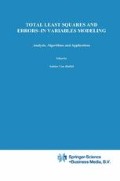Abstract
We introduce and study the structural line segment model, which is motivated by applications in the field of computer vision. The method of moments estimator (MME) is investigated under three different sets of assumptions. We derive the asymptotic distribution of the MME and study its performance numerically.
Access this chapter
Tax calculation will be finalised at checkout
Purchases are for personal use only
Preview
Unable to display preview. Download preview PDF.
References
K. Bruntjen and H. Späth. Incomplete total least squares. Numer. Math., 81: 52 1538, 1999.
C. Cheng and J.W. Van Ness. Statistical Regression with Measurement Error. Oxford University Press, New York, 1999.
O. Davidov and A. Goldenshluger. Fitting a line segment to noisy data. Submitted.
C.B. Madsen and H.I. Cristensen. Modeling and testing the stability of edge segments: length and orientation. In G. Borgefors, editor, Theory ll Applications of Image Processing II–Selected papers from the 9’th Scandinavian Conference on Image Analysis, pages 1–15. World Scientific Press, Singapore, 1995.
C.V. Stewart, K. Bubna, and A. Perera. Estimating model parameters and boundaries by minimizing a joint, robust objective function. In Proceedings of the IEEE Conf. on Computer Vision and Pattern Recognition, pages 387–393, 1999.
S. Van Huffel. Recent Advances in Total Least Squares Techniques and Errors-inVariables Modeling. SIAM, Philadelphia, 1997.
S. Van Huffel and J. Vandewalle. The Total Least Squares Problem: Computational Aspects and Analysis. SIAM, Philadelphia, 1991.
G. Vosselman and R. M. Haralick. Performance analysis of line and circle fitting in digital images. In H.I. Cristensen, W. Förstner, and C.B Madsen, editors, Proceedings of the Workshop on Performance Characteristics of Vision Algorithms,1996. Available at http://www.vision.auc.dk/hic/perf-proc.html.
M. Werman and D. Keren. A bayesian method for fitting parametric and non-parametric models to noisy data. IEEE Trans. Pattern Analysis and Machine Intelligence, 23: 528–534, 2001.
Author information
Authors and Affiliations
Editor information
Editors and Affiliations
Rights and permissions
Copyright information
© 2002 Springer Science+Business Media Dordrecht
About this chapter
Cite this chapter
Davidov, O., Goldenshluger, A., Reidman, R. (2002). On the Structural Line Segment Model. In: Van Huffel, S., Lemmerling, P. (eds) Total Least Squares and Errors-in-Variables Modeling. Springer, Dordrecht. https://doi.org/10.1007/978-94-017-3552-0_22
Download citation
DOI: https://doi.org/10.1007/978-94-017-3552-0_22
Publisher Name: Springer, Dordrecht
Print ISBN: 978-90-481-5957-4
Online ISBN: 978-94-017-3552-0
eBook Packages: Springer Book Archive

